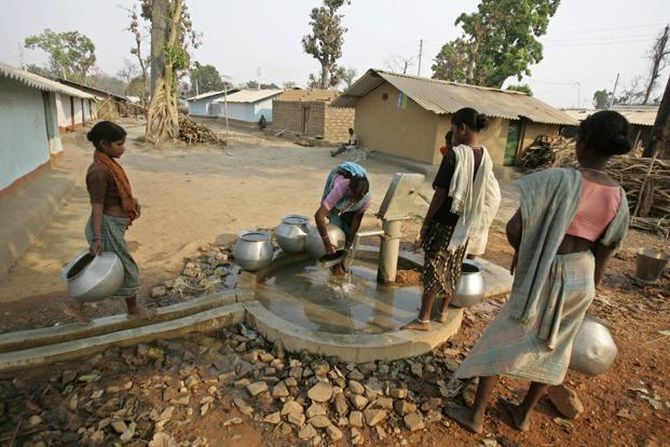
Inflation eats into India’s rural demand while green shoots become visible
August 11, 2022In May, Satpal Singh, who runs a dairy business with three buffaloes in Jewar, near Noida, was worried about the steep spike in input costs.
Singh said dry fodder rates, which cost Rs 1,500-2000 per tractor trolley last year, were quoting at Rs 4,500-5,000.
The price of other cattle feed ingredients (that include mustard meal and similar mixes) had also gone up from Rs 2,000 per quintal to Rs 3,100-3,200 per quintal.
The average feed cost per animal rose to Rs 125-150 per day in May and June; till a few months ago, it was less than Rs 100.
The problem was that the spike in milk prices was relatively moderate.
“In comparison to the input price hike, milk prices are still lower, which is making rearing animals difficult for us,” Singh had told Business Standard.
Singh’s predicament shows why recovery in rural areas has been slow, impacting demand across the board.
As Sanjiv Mehta, chairman and managing director of Hindustan Unilever Ltd (HUL), told Business Standard in a recent interview, “Weak rural demand has become a concern not just for the fast-moving consumer goods (FMCG) industry, but it has impacted sales of other consumer segments like consumer durables and apparels as well.”
Various non-official indicators point to green shoots of improvement in the broader rural sector — higher farm prices, rising economic activity in urban areas, which opens up work opportunities in the informal sector, and the general economic recovery.
But high inflation could take away all the gains.
Though inflation in several items has fallen after the March highs, the drop hasn’t been uniform across all commodities.
Also, relative to last year, prices are still high for many daily consumption items.
Crop prices have been robust in the last few months but the crop sector’s share in the average income of agricultural households has been falling.
So how far high crop prices contributed in pushing up incomes is a big question.
The Situational Assessment Survey (SAS) for 2018-19 showed that incomes from crop production in an agricultural household dropped to 37.7 per cent from 47.9 per cent in 2012-13, whereas wage income has risen from 32.2 per cent to 40.3 per cent.
At the same time, real wage growth has been poor.
Real rural wages of general agriculture labourers (male) — which is sometimes considered the benchmark — have either fallen or risen by minuscule proportions till June 2022.
“There has been stress in the rural economy for a prolonged period ever since the slowdown of 2017-18, so any recovery won’t be sudden,” Himanshu, associate professor at Jawaharlal Nehru University (JNU), told Business Standard.
He pointed out that the crop price rise is a short-term development against the overall trend of declining crop prices.
“Also, input prices are rising. I feel the stress in the rural economy is still strong as wages aren’t growing at a fast clip,” he added.
Demand for work under the flagship rural employment guarantee scheme (MGNREGA) remains robust, too.
Several economists say this is a reflection of the continued stress in the rural economy because MGNREGA jobs are sought by the poorest and most vulnerable sections as a last resort in the absence of other viable options.
In June 2022, 31.67 million households demanded work under MGNREGA.
This is only marginally lower than the 33.97 million in the same month last year, which was a pandemic year, but significantly higher than the figure of 25.43 million households in the pre-pandemic June of 2019-20.
In April and May this year, 23.26 million and 30.74 million households had sought work under the scheme.
This tepid recovery has had its impact on rural consumer goods sales.
In automobiles, for instance, Vinkesh Gulati, president of the Federation of Automobile Dealers’ Association, said, though rural sales have shown signs of improving month-on-month, there is still hesitancy in loosening the purse strings for discretionary purchases.
The Covid-19 Delta wave of 2021, which hit rural India harder, practically wiped out household savings.
Sales of the entry level two-wheelers and cars, which draw a big chunk of sales from rural India, remain under severe stress, Gulati said. Indeed, companies are yet to see any uptick.
“So far, it’s the urban markets that have led the volume growth,” Rakesh Sharma, executive director, Bajaj Auto, told reporters in a post-earnings call earlier this week.
He expects consumption in rural India to kick in from next month.
“The onset of the festive season will lead to some uptick, but it will be nowhere close to the pre-Covid years,” Gulati added.
But not everyone is as optimistic.
“I expect sales in rural India to recover only from the December quarter when the festive season peaks.
“The second quarter of any year is typically weak due to rains and sowing,” said Nikunj Sanghi, an Alwar, Rajasthan-based dealer of Hero MotoCorp and Mahindra & Mahindra.
Underlining the trend of sluggish discretionary purchases, car market leader Maruti Suzuki India saw the contribution of rural sales in its total volumes drop to 42 per cent in the April-June quarter of FY23 from 44 per cent in the January-March quarter of FY22.
For FMCGs, there is some optimism.
“We see some of the green shoots.
“One is that the government has done a sensible thing in terms of enhancing the commitment on fertiliser subsidy by nearly Rs 1.5 trillion, giving more free food to the rural population, and the monsoon saving it, except in the heartland where also the forecast indicates that the rain will catch up.
“In the rest of the country, the rain has been decent,” HUL’s Mehta told analysts after announcing its results.
He added, “If the realisation for crops is more than the input price inflation, then there will also be an increase in income for the farmers and that should augur well for them.
“So, these are factors that could result, in the coming quarters, in rural (demand) bouncing back from where it is today,” Mehta said.
Parle Products category head Mayank Shah said he has already seen a revival since the April-June quarter.
“There are three reasons for rural demand to continue to remain strong, one is the good progress of monsoon, better realisation of crops sold, which is a positive fall-out of inflation, and also the upcoming festive season comes after two years of muted celebrations and people are expected to go out and celebrate.”
He also said that Covid numbers are low, which also augurs well.
Against this optimism, the big question remains: How durable are these positive indicators?
As in the years past, it’s the monsoon that will determine that trajectory.
But the monsoon’s pattern in the first two months of the four-month season has been mixed.
It has rained heavily in central, southern and western India in July after a weak June.
But in the poorer states of Uttar Pradesh, Bihar, Jharkhand, West Bengal and parts of Odisha, the recovery hasn’t been up to the mark.
As a result, between June and the end of July, the area under the paddy crop has shrunk almost 13 per cent over the same period last year.
In any case, as S Mahendra Dev, director and vice-chancellor of the Mumbai-based Indira Gandhi Institute of Development Research, pointed out, “If the monsoons are good, we might see a revival in rural demand, but it might not come back to pre-pandemic levels yet.”
Source: Read Full Article



